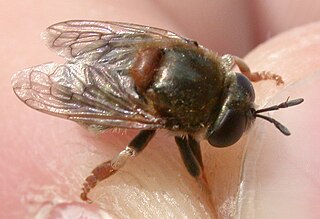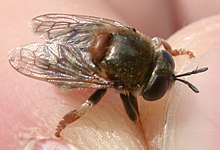
Hover flies of the genus Microdon are unusual among the Diptera. Like other members of the subfamily, they are myrmecophiles, meaning they inhabit the nests of ants.

Afromicrodon is an African genus of hoverflies. The species of the genus Afromicrodon were previously and erroneously placed in the genus Ceratophya.
Archimicrodon is a genus of hoverflies. Many of the species in this genus were moved from Microdon by Reemer & Ståhls (2013). Previously, it had been described as having three known species.
Ceratophya is a genus of hoverflies, with five known species. They are distinct from Microdon by the presence of an appendix on vein R4+5. Many species have erroneously been placed in this genus. Some authors place Ceratophya as a subgenus of Microdon.
Chrysidimyia is a genus of hoverflies from Brazil, with only one known species, Chrysidimyia chrysidimima. The genus was described as a small metallic green fly with dense punctation that had an "astonishing resemblance" to chrysidid wasps.
Chymophila is a subgenus of the hoverfly genus Microdon. It was previously considered to be exclusively Neotropical, but is now also known from the Nearctic and Oriental realms, and one species is known from Japan. Chymophila was based on a composite type species: the holotype is a body of C. fulgens with the head of a conopid glued on.
Hovamicrodon is a subgenus of the hoverfly genus Archimicrodon, endemic to Madagascar. Hovamicrodon is distinguished by a particular type of scutellar calcar, being broad and blunt apically.
Indascia is a genus of hoverflies native to India and Sri Lanka. Indascia is very similar to Paramicrodon.
Megodon is a subgenus of the hoverfly genus Microdon. It is native to Madagascar, and contains only two known species. Microdon stuckenbergi has an unusual scutellum. Larvae are found in ant nests.
Mixogaster is a genus of hoverflies native to North America and South America, with 21 known species. Mixogaster is distinct by lacking an appendix on vein R4+5, having a reduced and bare metasternum, an unarmed scutellum, and usually an appendix on vein M extending in cell R4+5. Larvae are found in ant nests.
Myiacerapis is a subgenus of the hoverfly genus Microdon. It contains only one species, Microdon villosus. It is native to Uganda, though an undescribed species is known from South Africa. Larvae are found in ant nests.
Oligeriops is a genus of hoverfly from Australia. They are characterised by the reduced size of the eyes, and the genus includes five described species. It was previously considered a synonym of Microdon.
Paramicrodon is a genus of hoverflies, with eight known species. They differ from Microdon by their short antennae and the lack of appendices on vein R4+5.
Pseudomicrodon is a genus of hoverflies, with 14 known species. All are species with petiolate abdomens.
Rhopalosyrphus is a genus of hoverflies, with nine known species. The adults flies mimic wasps, such as Zethus. The larvae are predators of ant brood. They are native to from southern United States to northern Argentina.
Spheginobaccha is a genus of hoverflies, with 15 known species. The genus is readily separated from other microdons by the incomplete metathoracic bridge, round/oval basoflagellomere, occiput with a dorsolateral crease, and other characters.
Syrphipogon is a subgenus of the hoverfly genus Microdon. There are two known species. They are very large microdontine flies of about 25 mm. They have a deeply sulcate scutellum and a facial mystax. They are mimics of the large bees of the genus Eulaema.
Peradon is a genus of hoverfly from the Neotropical realm, containing 31 species. Many of the species were originally described in the genus Microdon.
Metadon is a genus of hoverfly containing 43 species. Most of the species were originally described in the genus Microdon.


